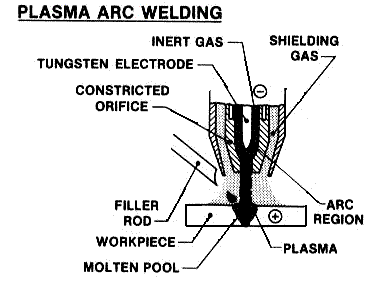In plasma arc welding, a shielded arc is struck between a non consumable electrode and the torch body, and this arc transforms an inert gas into plasma. A plasma is a gas which is heated to an extremely high temperature and ionized so that it becomes electrically conductive. Similar to GTAW (TIG), the plasma arc welding process uses this plasma to transfer an electric arc to a work piece. The metal to be welded is melted by the intense heat of the arc and fuses together. In the plasma welding torch a tungsten electrode is located within a copper nozzle having a small opening at the tip. A pilot arc is initiated between the torch electrode and nozzle tip. This arc is then transferred to the metal to be welded. Shielding gas is obtained from the hot ionized gas issuing from the orifice. Auxiliary inert shielding gas or a mixture of inert gases is normally used.
 By forcing the plasma gas and arc through a constricted orifice, the torch delivers a high concentration of heat to a small area. With high performance welding equipment, the plasma process produces exceptionally high quality welds. Like gas tungsten arc welding, the plasma arc welding process can be used to weld most commercial metals, and it can be used for a wide variety of metal thicknesses.
By forcing the plasma gas and arc through a constricted orifice, the torch delivers a high concentration of heat to a small area. With high performance welding equipment, the plasma process produces exceptionally high quality welds. Like gas tungsten arc welding, the plasma arc welding process can be used to weld most commercial metals, and it can be used for a wide variety of metal thicknesses.
(Robot Welding dot com)

No comments:
Post a Comment